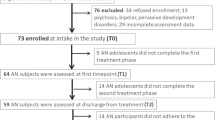Abstract
The purpose of the present study was to characterize the psychopathology measured ten years posttreatment in 51 women who had an adolescent onset of anorexia nervosa. Outcome status was determined using the modified categories of Ratnasuriya et al.[1991]. “Anorexia Nervosa: Outcome and Prognostic Factors After 20 Years,” British Journal of Psychiatry, Vol. 158, pp. 495–502). Psychopathology was assessed using a number of self-report questionnaires: Beck Depression Inventory, Hamilton Depression Inventory, Leyton Obsessionality Inventory, Social Adjustment Scale, and Minnesota Multiphasic Personality Inventory. Within this adolescent age of onset sample of anorexia nervosa, age of onset was not, in and of itself, associated with increased psychopathology at follow-up. Rather, severity of eating disorder outcome was associated with general psychopathology, with patients in the poor outcome group displaying elevations on several of the measures of psychopathology.
Similar content being viewed by others
References
Beck, A. T., Steer, R. A., and Garbin, M. G. (1988). Psychometric properties of the Beck Depression Inventory: Twenty-five years of evaluation.Clin. Psychol. Rev. 8: 77–100.
Beck, A. T., Ward, C. H., Mendelson, M., Mock, J., and Erbaugh, J. (1961). An inventory for measuring depression.Arch. Gen. Psychiat. 4: 561–570
Bryant-Waugh, R., Knibbs, J., Fosson, A., Kaminski, Z., and Lask, B. (1988). Long term follow up of patients with early onset anorexia nervosa.Arch. Dis. Child. 63: 5–9.
Cooper, J. (1970). The Leyton Obsessional Inventory.Psychol. Med. 1: 48–64.
Dahlstrom, W. G., Welsh, G. S., and Dahlstrom, L. E. (1982).An MMPI Handbook, Vol. 1, Clinical Interpretation. University of Minnesota Press, Minneapolis.
Derogatis, L. R., Lipman, R. S., Rickels, K., Uhlenhuth, E. H., and Covi, L. (1974). The Hopkins Symptom Checklist (HSCL): A self-report symptom inventory.Behav. Sci. 19: 1–15.
Eckert, E. D., Halmi, K. A., Marchi, P., Grove, W., and Crosby, R. (1995). Ten-year follow-up of anorexia nervosa: clinical course and outcome.Psycholog. Med. 25: 143–156.
Halmi, K., Brodland, G., and Loney, J. (1973). Prognosis in anorexia nervosa.Ann. Int. Med. 78: 907–909.
Halmi, K. A., Eckert, E., Marchi, P., Sampugnaro, V., Apple, R., and Cohen, J. (1991). Comorbidity of psychiatric diagnoses in anorexia nervosa.Arch. Gen. Psychiat. 48: 712–718.
Halmi, K. A., Goldberg, S. C., Casper, R. C., Eckert, E. D., and Davis, J. M. (1979). Pretreatment predictors of outcome in anorexia nervosa.Br. J. Psychiat. 134: 71–78.
Hamilton, M. (1960). A rating scale for depression.J. Neurol. Neurosurg. Psychiat. 23: 56–62.
Herzog, D. B., Keller, M. B., and Lavori, P. W. (1988). Outcome in anorexia nervosa and bulimia nervosa: A review of the literature.J. Nerv. Ment. Disease. 176: 131–143.
Herzog, D. B., Sacks, N. R., Keller, M. B., Lavori, P. W., von Ranson, K. B., and Gray, H. M. (1993). Patterns and predictors of recovery in anorexia nervosa and bulimia nervosa.J. Am. Acad. Child Adolesc. Psychiat. 32: 835–842.
Morgan, H. G., Purgold, J., and Welbourne, J. (1983). Management and outcome in anorexia nervosa: A standardized prognostic study.Br. J. Psychiat. 143: 282–287.
Morgan, H. G., and Russell, G. F. M. (1975). Value of family background and clinical features as predictors of long-term outcome in anorexia nervosa: Four-year follow-up study of 41 patients.Psychol. Med. 5: 355–371.
Murray, R. M., Cooper, J. E., and Smith, A. (1979). The Leyton Obsessional Inventory: An analysis of the responses of 73 obsessional patients.Psychol. Med. 9: 305–311.
Pierloot, R. A., Wellens, W., and Houben, M. E. (1975). Elements of resistance to a combined medical and psychotherapeutic program in anorexia nervosa.Psychother. Psychosom. 26: 101–117.
Ratnasuriya, R. H., Eisler, I., Szmukler, G. I., and Russell, G. F. M. (1991). Anorexia nervosa: Outcome and prognostic factors after 20 years.Br. J. Psychiat. 158: 495–502.
Rollins, N., andPiazza, E. (1981). Anorexia nervosa: A quantitative approach to follow-up.J. Am. Acad. Child Psychiat. 20: 167–183.
Schork, E. J., Eckert, E. D., and Halmi, K. A. (1994). The relationship between psychopathology, eating disorder diagnosis, and clinical outcome at 10-year follow-up in anorexia nervosa.Comp. Psychiat. 35: 113–123.
Seidensticker, J. F., and Tzagournis, M. (1968). Anorexia nervosa—clinical features and long term follow-up.J. Chron. Dis. 21: 361–367.
Steinhausen, H-C. and Seidel, R. (1993). Outcome in adolescent eating disorders.Int. J. Eat. Disord. 14: 487–496.
Strober, M. (1980). Personality and symptomatological features in young, nonchronic anorexia nervosa patients.J. Psychosom. Res. 24, 353–359.
Suematsu, H., Kuboki, T., and Itoh, T. (1985). Statistical studies on the prognosis of anorexia nervosa.Psychother. Psychosom. 43: 104–112.
Swift, W. J. (1982). The long-term outcome of early onset anorexia nervosa.J. Am. Acad. Child Psychiat. 21: 38–46.
Walford, G., and McCune, N. (1991). Long-term outcome in early-onset anorexia nervosa.Br. J. Psychiat. 159: 383–389.
Weissman, M. M., and Bothwell, S. (1976). Assessment of social adjustment by patient self-report.Arch. Gen. Psychiat. 33: 1111–1115.
Weissman, M. M., Prusoff, B. A., Thompson, W. D., Harding, P. S., and Myers, J. K. (1978).J. Nerv. Ment. Dis. 166: 317–326.
Author information
Authors and Affiliations
Additional information
Received Ph.D. in psychology from Rutgers Univesity. Major research interests are in eating behavior and attitudes toward foods in anorexia and bulimia nervosa, preoccupations and rituals associated with eating disorders, and comorbidity and eating disorders.
Received M.D. from the University of Medicine and Dentistry in New Jersey. Research interests are in eating disorders.
Received M.D. from University of Minnesota Medical School-Minneapolis, MN. Major research interests are anorexia nervosa and other eating disorders.
Received M.D. from the University of Iowa—Iowa City. Research interests are in eating disorders.
Rights and permissions
About this article
Cite this article
Sunday, S.R., Reeman, I.M., Eckert, E. et al. Ten-Year outcome in adolescent onset anorexia nervosa. J Youth Adolescence 25, 533–544 (1996). https://doi.org/10.1007/BF01537547
Received:
Accepted:
Issue Date:
DOI: https://doi.org/10.1007/BF01537547




